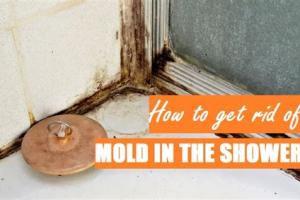Ultimate Guide: How to Easily Get Rid of Mold in Your Bathroom and Shower

-
Quick Links:
- Introduction
- What is Mold?
- Why Does Mold Grow in Bathrooms?
- Health Risks of Mold Exposure
- How to Identify Mold
- Preventive Measures
- Step-by-Step Guide to Remove Mold
- Natural Remedies for Mold Removal
- When to Call Professionals
- Case Studies
- Expert Insights
- FAQs
Introduction
Mold is a common problem in bathrooms and showers, thriving in the warm, humid environment. Not only is it unsightly, but it can also pose significant health risks. In this comprehensive guide, we will explore how to effectively get rid of mold in your bathroom and shower, as well as preventative measures to keep it from returning.
What is Mold?
Mold is a type of fungus that grows in multicellular filaments called hyphae. It thrives in damp environments and can be found in various colors, including black, green, and white. Mold reproduces through spores, which can be airborne and lead to health issues when inhaled.
Why Does Mold Grow in Bathrooms?
Bathrooms are often the perfect breeding ground for mold due to:
- High humidity levels from showers and baths.
- Poor ventilation that traps moisture.
- Water leaks and plumbing issues.
- Organic materials such as soap scum and hair that provide food for mold.
Health Risks of Mold Exposure
Exposure to mold can lead to various health issues, including:
- Allergic reactions
- Respiratory problems
- Skin irritation
- Aggravation of asthma
- Potential toxic effects from mycotoxins
How to Identify Mold
Identifying mold early can help mitigate health risks. Look for:
- Visible growth on walls, ceilings, and tiles.
- Musty odors that linger.
- Water stains or discoloration on surfaces.
Preventive Measures
To prevent mold growth, consider the following tips:
- Ensure proper ventilation by using exhaust fans or opening windows.
- Regularly clean and dry surfaces, especially after use.
- Fix any leaks promptly.
- Use mold-resistant paint and materials.
Step-by-Step Guide to Remove Mold
Follow these steps to effectively remove mold:
- Gather Your Supplies: You will need gloves, a mask, a scrub brush, and a cleaning solution (bleach, vinegar, or a commercial mold remover).
- Ventilate the Area: Open windows and doors to ensure proper airflow.
- Apply the Cleaning Solution: Spray the affected areas and let it sit for 10-15 minutes.
- Scrub the Area: Use a scrub brush to remove mold from surfaces.
- Rinse and Dry: Rinse the area with clean water and dry thoroughly to prevent regrowth.
Natural Remedies for Mold Removal
If you prefer natural solutions, consider these options:
- Vinegar: Spray undiluted vinegar on the mold and let it sit before wiping off.
- Baking Soda: Mix baking soda with water to create a paste, apply it to the mold, and scrub.
- Tea Tree Oil: Combine tea tree oil with water in a spray bottle for a natural mold killer.
When to Call Professionals
If the mold problem is extensive or recurring, consider hiring professionals. They can provide:
- Thorough inspections
- Advanced removal techniques
- Prevention strategies
Case Studies
Case studies can illustrate effective mold removal strategies. For example, a family in Seattle faced recurrent mold issues due to high humidity. After implementing ventilation improvements and regular cleaning protocols, they successfully eliminated mold and improved indoor air quality.
Expert Insights
We consulted mold remediation experts who emphasize the importance of early detection and consistent maintenance. They recommend using a dehumidifier in bathrooms to keep humidity levels below 50%.
FAQs
FAQs
1. What causes mold in the bathroom?
Mold thrives in damp, humid environments, making bathrooms ideal if not properly ventilated.
2. How can I prevent mold from coming back?
Ensure adequate ventilation, fix leaks promptly, and clean regularly.
3. Is it safe to remove mold myself?
For small areas, yes, but always wear protective gear and consider professional help for large infestations.
4. What cleaning products are best for mold?
Bleach, vinegar, and commercial mold removers are effective for cleaning mold.
5. Can mold cause health issues?
Yes, mold can trigger allergies, respiratory problems, and other health issues.
6. How often should I check my bathroom for mold?
Regular checks, ideally monthly, can help catch mold growth early.
7. What should I do if I have a mold allergy?
Consider consulting a healthcare provider and ensure your living space is mold-free.
8. Can I use bleach on all surfaces?
No, avoid using bleach on porous surfaces as it may not be effective and could lead to further damage.
9. How long does it take to remove mold completely?
It depends on the extent of the infestation; small patches can be removed in a few hours, while larger areas may take longer.
10. What should I do if I see black mold?
Take immediate action to remove it and consult professionals if necessary, as black mold can be particularly hazardous.
Random Reads